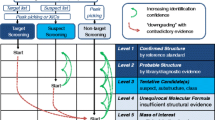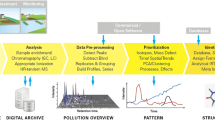Abstract
High-resolution mass spectrometry (HRMS) has become an important tool for monitoring chemical residues in food, but the time and effort required to evaluate the large amount of data generated by HRMS can be a limiting factor in the widespread application of this tool. Suspect screening, i.e., searching HRMS data against large compound databases or mass lists, represents a practical compromise between using HRMS data to only look for target compounds and performing full non-target analysis. Several different approaches for suspect screening using HRMS data were tested using data from shrimp and eel spiked with veterinary drugs and pesticides as well as from imported aquaculture samples. Most of the analytes (>70%) in the spiked samples were detected and identified by searching against compound databases. To query larger databases and on-line resources such as mzCloud, it was necessary to use software capable of differential analysis and selective filtering, such as Compound Discoverer. Using selective filtering, the number of compounds detected in fish sample extracts could be reduced from tens of thousands to a few hundred by subtracting method blanks and comparing to matrix blank extracts. This smaller list of potential compounds could be further evaluated and compared to available databases and libraries. Analysis of imported aquaculture samples resulted in detection of unexpected contaminants including the dewormer levamisole, the insecticide buprofezin, and potentially the plant alkaloid ricinine.
Graphical Abstract





Similar content being viewed by others
References
Turnipseed SB, Storey JM, Lohne JJ, Andersen WC, Burger RJ, Johnson AS, Madson MR. Wide-scope screening method for multiclass veterinary drug residues in fish, shrimp, and eel using liquid chromatography-quadrupole high-resolution mass spectrometry. J Agric Food Chem. 2017;65:7252–67.
Turnipseed SB, Storey JM, Wu I-L, Gieseker C, Hasbrouck N, Crosby TC, Andersen WC, Lanier S, Casey CR, Burger R, Madson MR. Application and evaluation of a high-resolution mass spectrometry screening method for veterinary drug residues in incurred fish and imported aquaculture samples. Anal Bioanal Chem. 2018;410:5529–44.
Turnipseed SB, Storey JM, Wu I-L, Andersen WC, Madson MR. Extended liquid chromatography high resolution mass spectrometry screening method for veterinary drug, pesticide and human pharmaceutical residues in aquaculture fish. Food Addit Contam A. 2019;36:1501–14.
Casey CR, Turnipseed SB. Updates to LIBs #4615/4616 Screening method for veterinary drug residues using LC-HRMS: validation in shrimp. FDA Laboratory Information Bulletin #4673. 2021. https://www.fda.gov/science-research/field-science-and-laboratories/laboratory-information-bulletins. Accessed 8 Sept 2023.
US Food and Drug Administration. Enhancing the safety of imported shrimp through regulatory partnerships. 2022. https://www.fda.gov/food/conversations-experts-food-topics/enhancing-safety-imported-shrimp-through-regulatory-partnerships. Accessed 8 Sept 2023.
Wu I-L, Turnipseed SB, Storey JM, Andersen WC, Madson MR. Comparison of various data acquisition modes with Orbitrap high resolution mass spectrometry for targeted and non-targeted residue screening in aquacultured eel. Rapid Commun Mass Spectrom. 2020;34:e8642.
Knolhoff AM, Premo JH, Fisher CM. A proposed quality control standard mixture and its uses for evaluating nontargeted and suspect screening LC/HR-MS method performance. Anal Chem. 2021;93:1596–603.
Wong JW, Wang J, Chow W, Carlson R, Jia Z, Zhang K, Hayward D, Chang JS. Perspectives on liquid chromatography-high resolution mass spectrometry for pesticide screening in foods. J Agric Food Chem. 2018;66:9573–81.
Jansen LJM, Nijssen R, Bolck YJC, Wegh RS, van de Schans MGM, Berendsen BJA. Systematic assessment of acquisition and data-processing parameters in the suspect screening of veterinary drugs in archive matrices using LC-HRMS. Food Addit Contam A. 2022;39:272–84.
Wong JW, Wang J, Chang JS, Chow W, Carlson R, Rajski L, Fernández-Alba AR, Self R, Cooke WK, Lock CM, Mercer GE, Mastovska K, Schmitz J, Vaclavik L, Li L, Panwennage D, Pang GF, Zhou H, Miao S, Ho C, MORE. Multilaboratory collaborative study of a nontarget data acquisition for target analysis (nDATA) workflow using liquid chromatography-high-resolution accurate mass spectrometry for pesticide screening in fruits and vegetables. J Agric Food Chem. 2021;69:13200–16.
Krauss M, Singer H, Hollender J. LC-high resolution MS in environmental analysis: from target screening to the identification of unknowns. Anal Bioanal Chem. 2010;397:943–51.
Knolhoff AM, Fisher CM. Strategies for data reduction in non-targeted screening analysis: The impact of sample variability for food safety applications. Food Chem. 2021;350:128540.
Peter KT, Phillips AL, Knolhoff AM, Gardinali PR, Manzano CA, Miller KE, Pristner M, Sabourin L, Sumarah MW, Warth B, Sobus JR. Nontargeted analysis study reporting tool: A framework to improve research transparency and reproducibility. Anal Chem. 2021;93:13870–9.
Schymanski EL, Jeon J, Gulde R, Fenner K, Ruff M, Singer HP, Hollender J. Identifying small molecules via high resolution mass spectrometry: communicating confidence. Environ Sci Tech. 2014;48:2097–8.
Pourchet M, Debrauwer L, Klanova J, Price EJ, Covaci A, Caballero-Casero N, Oberacher H, Lamoree M, Damont A, Fenaille F, Vlaanderen J, Meijer J, Krauss M, Sarigiannis D, Barouki R, Le Bizec B, Antignac JP. Suspect and non-targeted screening of chemicals of emerging concern for human biomonitoring, environmental health studies and support to risk assessment: from promises to challenges and harmonisation issues. Environ Int. 2020;139:105545.
Jongedijk E, Fifeik M, Arrizabalaga-Larranaga A, Polzer J, Blokland M, Sterk S. Use of high-resolution mass spectrometry for veterinary drug multi-residue analysis. Food Control. 2023;145:109488.
US Food and Drug Administration. Chemotherapeutics in Seafood Compliance Program 7304.018. 2017. https://www.fda.gov/food/compliance-enforcement-food/food-compliance-programs#food_ds. Accessed 8 Sept 2023.
Tian L, Verreault J, Houde M, Bayen S. Suspect screening of plastic-related chemicals in northern pike (Esox lucius) from the St. Lawrence River, Canada. Environ Pollut. 2019;225:113223.
Kunzelmann M, Winter M, Åberg M, Hellenäs K-E, Rosén J. Non-targeted analysis of unexpected food contaminants using LC-HRMS. Anal Bioanal Chem. 2018;410:5593–602.
US Food and Drug Administration. Acceptance criteria for confirmation of identity of chemical residues using exact mass data for the FDA Foods and Veterinary Medicine Program. 2015. https://www.fda.gov/science-research/field-science-and-laboratories/method-validation-guidelines. Accessed 8 Sept 2023.
HighChem LLC. www.mzcloud.org. 2023. Accessed 8 Sept 2023.
Majumder S, Mandal S, Majumder B, Paul A, Paul T, Sahana N, Mondal P. A liquid chromatographic method for determination of acetamiprid and buprofezin residues and their dissipation kinetics in paddy matrices and soil. Environ Science Pollut Res. 2022;29:1401–12.
US Food and Drug Administration. Pesticide residue monitoring program fiscal year 2020 pesticide report. 2020. https://www.fda.gov/food/cfsan-constituent-updates/fda-releases-fy-2020-pesticide-residue-monitoring-report. Accessed 8 Sept 2023.
Baruah N, Prasad KP. Influence of dietary intake of levamisole on growth and survivial of Macrobrachium rosenbergii (Palaemonidae, de Man). Asian Fish Sci. 2005;18:25–31.
Xu N, Dong J, Yang Y, Liu Y, Yang Q, Ai X. Development of a liquid chromatography-tandem mass spectrometry method with modified QuEChERS extraction for the quantification of mebendazole and its metabolites, albendazole and its metabolites, and levamisole in edible tissues of aquatic animals. Food Chem. 2018;269:442–9.
Black SM, Muneem S, Miller-Tuck D, Kassim PA. Quantitative analysis of L-abrine and ricinine spiked into selected food matrices by liquid chromatography- tandem mass spectrometry. Chromatogr Sep Tech. 2015;6:265.
Zheng K-X, Liu C, Wang S, Tzou Y, Chiang C, Lin S, Yang H, Wu J, Chuang Y. Evaluating the release and metabolism of ricinine from castor cake fertilizer in soils using a LC-QTOF/MS coupled with SIRIUS workflow. Chemosphere. 2023;310:136865.
Mondal B, Bera M, Das K. Castor bean cake: a paradox of toxicity and nutrient source in farm anaimals and aquaculture. Indian J Anim Health. 2019;58:157–70.
Bethem R, Boison J, Gale J, Heller D, Lehotay S, Loo J, Musser S, Price P, Stein S. Establishing the fitness for purpose of mass spectrometer methods. J Am Soc Mass Spectrom. 2003;14:528–41.
Zhu C, Lai G, Jin Y, Xu D, Chen J, Jiang X, Wang S, Liu G, Xu N, Shen R, Wang L, Zhu M, Wu C. Suspect screening and untargeted analysis of veterinary drugs in food by LC-HRMS: application of background exclusion-dependent acquisition for retrospective analysis of unknown xenobiotics. J Pharm Biomed Anal. 2022;210:114583.
Acknowledgements
The authors would like to thank others at the US FDA, particularly the Denver Laboratory, for their role in sample preparation and helpful discussions.
Author information
Authors and Affiliations
Corresponding author
Additional information
Publisher's Note
Springer Nature remains neutral with regard to jurisdictional claims in published maps and institutional affiliations.
Published in the topical collection Food Safety Analysis 2.0 with guest editor Steven J. Lehotay.
Supplementary Information
Below is the link to the electronic supplementary material.
Rights and permissions
About this article
Cite this article
B. Turnipseed, S., R. Casey, C. Suspect screening for chemical residues in aquacultured shrimp and fish using liquid chromatography-high resolution mass spectrometry: comparison of data evaluation approaches. Anal Bioanal Chem 416, 733–744 (2024). https://doi.org/10.1007/s00216-023-04927-w
Received:
Revised:
Accepted:
Published:
Issue Date:
DOI: https://doi.org/10.1007/s00216-023-04927-w




